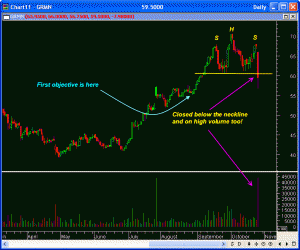The Head and Shoulders formation in probably the best known formation among traders. This post looks at how to trade this chart pattern.
First, when you seek to identify a formation as a head and shoulder top, you are trying to figure out a ‘reversal’ pattern. This is different from a continuation pattern. When one speaks of a reversal, naturally he/she should look for a prior trend that should be reversed. Put another way, a head and shoulders top should occur at the TOP. I have often seen people pointing out a consolidation pattern in a DOWN trend and calling it a head and shoulders top! So, remember, a head and shoulders TOP should occur near the TOP of an UP trend. (likewise, a head and shoulders bottom should occur at the end of a downtrend).
Take a look at the chart below.

Let us see how to trade this chart formation. Suppose you are a fan of Elliott Wave analysis. You would have already observed the completion of five waves at the “Head” of the formation. The right shoulder will be the ‘B’ wave of the correction that should inevitably follow the completion of a five wave impulse move. So the right ingredients are already in place, and you will have a lot more confidence about trading this pattern. Understand that a head and shoulders pattern is confirmed only when the neckline breaks. I have seen so many ‘potential’ head and shoulders pattern change shape and become a different animal altogether. When you see the neckline break on high volume, you should start by selling a small amount. Save the larger chunk of your position to be added on a pull back to the neckline. This will often give you a better average, and your stop-loss can also be placed at a nearer level. The best point to place your stop loss is just above the trend line that you can draw by connecting the head and the right shoulder. This point usually falls ABOVE the neckline, but it is a safer place. Some traders would place a stop just above the neckline, but will reinstate the position if they get stopped when the stock starts moving down after failing to break above the trendline just discussed.
A head and shoulders reversal pattern is not only easy to spot and easy to trade, it is often a very profitable opportunity to take a low risk trading position.
Where should one take profit on this short trade? The MINIMUM objective is a distance equal to the measure of the vertical distance from the top of the head to the neckline, subtracted from the breakout point. But a lot depends on the previous five wave bull run. If that was a very large up-move, you should stick with a core short position, using a trailing stop. The earliest level where one should consider taking some profits should be near the previous fourth wave.
What about a head and shoulders bottom? The rules are the same, except for one qualification. Whereas for a head and shoulder top it is not mandatory for an increase in volume as the neckline breaks ( it is just desirable), in the case of a head and shoudlers bottom it is absolutely essential for the volume to be very high. If you see a right shoulder rally breaking above the neckline of a bottom formation on LOW volume, be very very careful because the chances for a failure is very high.
To sum up, a head and shoulders reversal pattern is not only easy to spot and easy to trade, it is often a very profitable opportunity to take a low risk trading position. The pattern works in all types of markets, including stock market, forex market and the commodities market. So long as you follow sound money-management techniques, you should never pass a head and shoulders pattern.

